Analyzing the Impact of Natural Disasters on Poverty in Philippines
VerifiedAdded on 2021/06/17
|9
|1834
|386
Report
AI Summary
This report investigates the significant impact of natural disasters on poverty in the Philippines. The Philippines, being highly prone to natural disasters such as earthquakes, floods, volcanic eruptions, and typhoons, faces recurring challenges of poverty and inequality. The study highlights how these disasters exacerbate poverty by displacing people, destroying crops, and damaging infrastructure, leading to reduced food production, increased prices, and economic losses. The report also examines the role of environmental degradation, lack of investment, and government finances in reinforcing poverty. It emphasizes the need for advancements in technology, clean water, refined fuels, and industrial development to mitigate the effects of disasters and improve the living standards of Filipinos. The report uses figures and tables to illustrate the trends of hazards and the impact of specific events like Typhoon Haiyan and Typhoon Nesat, offering a comprehensive overview of the disaster-poverty nexus in the Philippines, supported by cited references.
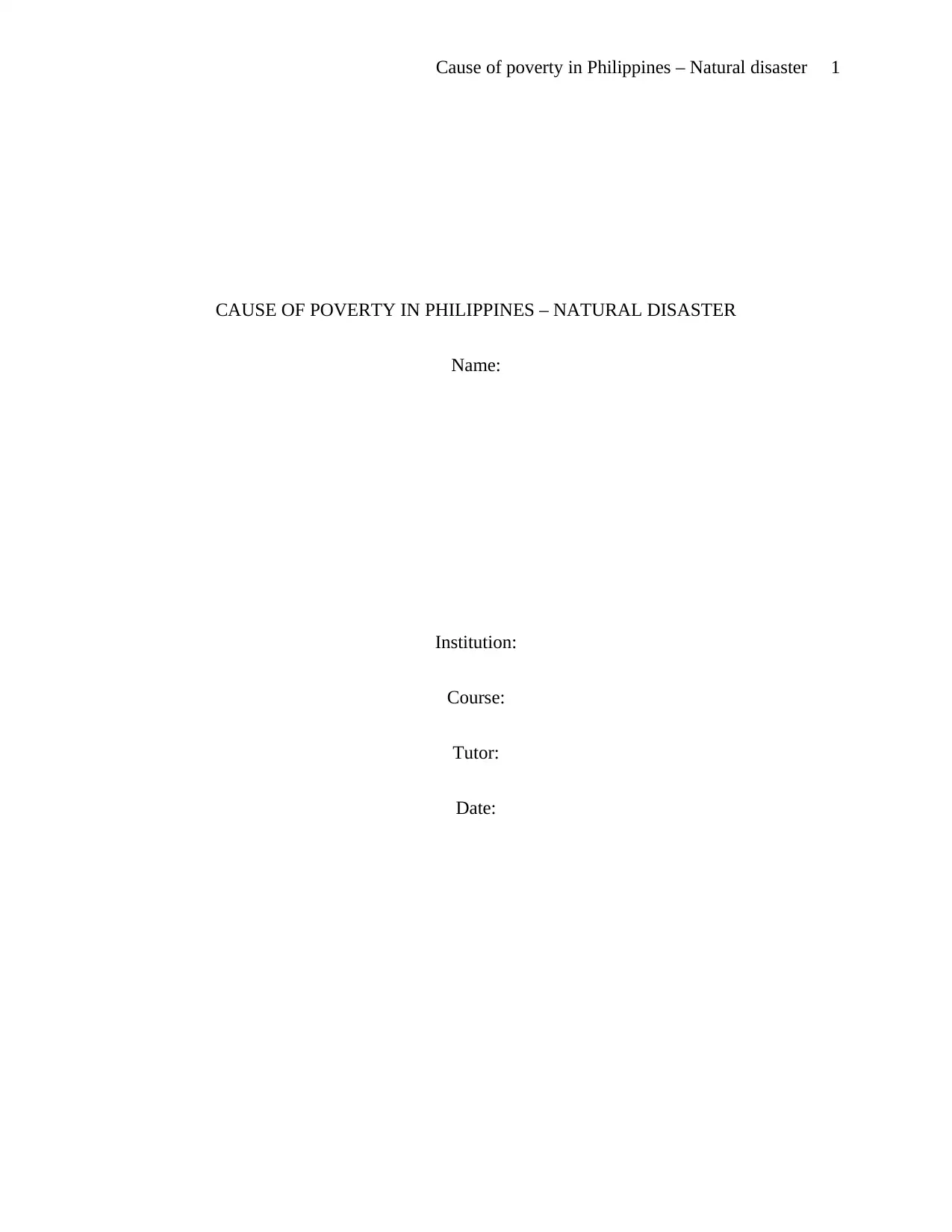
Cause of poverty in Philippines – Natural disaster 1
CAUSE OF POVERTY IN PHILIPPINES – NATURAL DISASTER
Name:
Institution:
Course:
Tutor:
Date:
CAUSE OF POVERTY IN PHILIPPINES – NATURAL DISASTER
Name:
Institution:
Course:
Tutor:
Date:
Paraphrase This Document
Need a fresh take? Get an instant paraphrase of this document with our AI Paraphraser
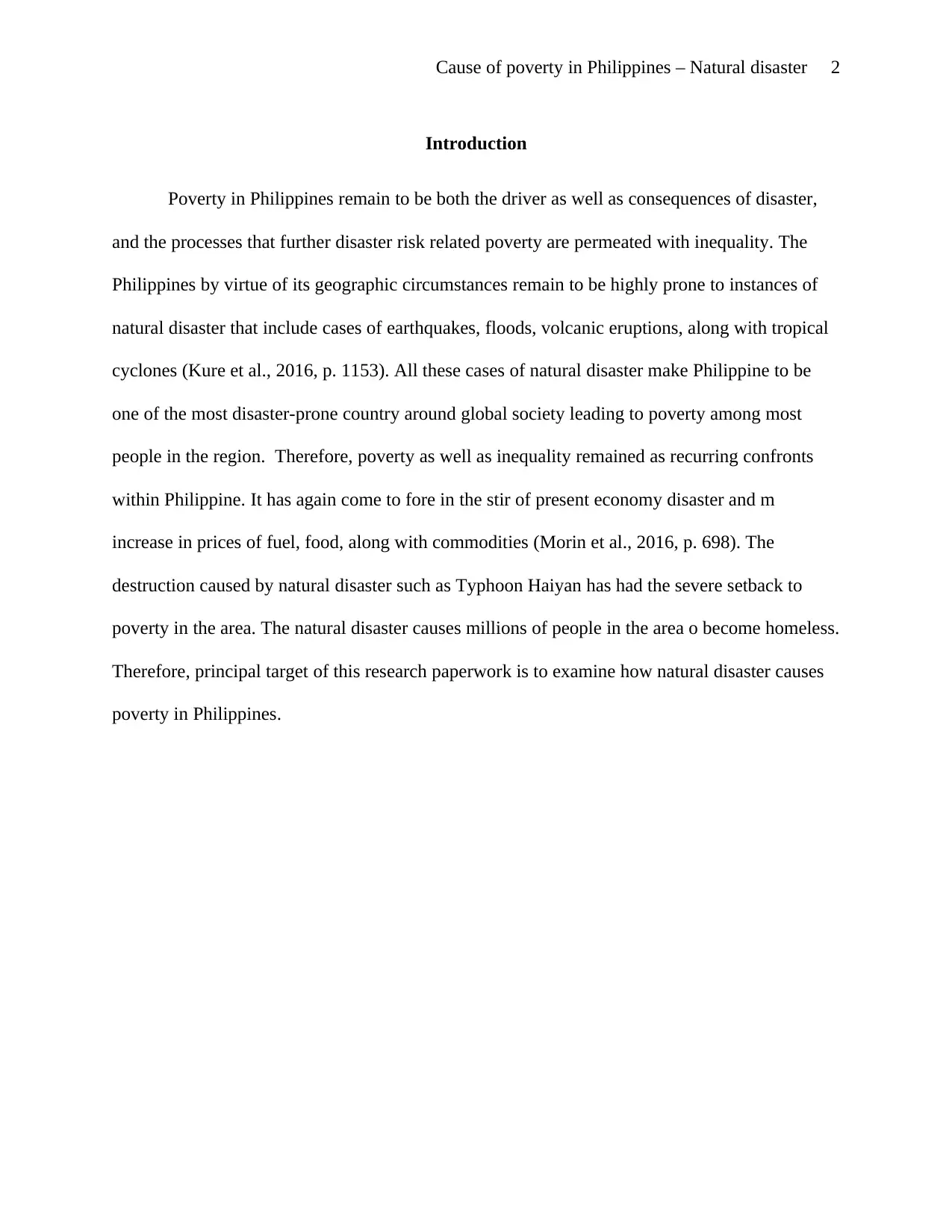
Cause of poverty in Philippines – Natural disaster 2
Introduction
Poverty in Philippines remain to be both the driver as well as consequences of disaster,
and the processes that further disaster risk related poverty are permeated with inequality. The
Philippines by virtue of its geographic circumstances remain to be highly prone to instances of
natural disaster that include cases of earthquakes, floods, volcanic eruptions, along with tropical
cyclones (Kure et al., 2016, p. 1153). All these cases of natural disaster make Philippine to be
one of the most disaster-prone country around global society leading to poverty among most
people in the region. Therefore, poverty as well as inequality remained as recurring confronts
within Philippine. It has again come to fore in the stir of present economy disaster and m
increase in prices of fuel, food, along with commodities (Morin et al., 2016, p. 698). The
destruction caused by natural disaster such as Typhoon Haiyan has had the severe setback to
poverty in the area. The natural disaster causes millions of people in the area o become homeless.
Therefore, principal target of this research paperwork is to examine how natural disaster causes
poverty in Philippines.
Introduction
Poverty in Philippines remain to be both the driver as well as consequences of disaster,
and the processes that further disaster risk related poverty are permeated with inequality. The
Philippines by virtue of its geographic circumstances remain to be highly prone to instances of
natural disaster that include cases of earthquakes, floods, volcanic eruptions, along with tropical
cyclones (Kure et al., 2016, p. 1153). All these cases of natural disaster make Philippine to be
one of the most disaster-prone country around global society leading to poverty among most
people in the region. Therefore, poverty as well as inequality remained as recurring confronts
within Philippine. It has again come to fore in the stir of present economy disaster and m
increase in prices of fuel, food, along with commodities (Morin et al., 2016, p. 698). The
destruction caused by natural disaster such as Typhoon Haiyan has had the severe setback to
poverty in the area. The natural disaster causes millions of people in the area o become homeless.
Therefore, principal target of this research paperwork is to examine how natural disaster causes
poverty in Philippines.

Cause of poverty in Philippines – Natural disaster 3
Figure 1: Illustrating trends of Hazard in Philippines from 1970 to 2005
How natural disaster causes poverty in Philippines
The Philippines has been subjected to a single natural disaster after another, and the
effect of these on economy of the region has been exacerbated by geography, poverty, along with
poor infrastructure. Instances like flooding raises poverty level in the area as the running water
always displaces people from their homes and in most cases destroy their farms making them to
lack food (Andriesse and Lee 2017, p. 32). Destruction of crops by floods, earthquakes, and
volcanic eruption leads to reduced production by farmers making it tough for the government to
be able to offer aid food to the entire population around Philippines. In most cases, people who
have their normal operations affected tend to take more time for them to be able to have enough
Figure 1: Illustrating trends of Hazard in Philippines from 1970 to 2005
How natural disaster causes poverty in Philippines
The Philippines has been subjected to a single natural disaster after another, and the
effect of these on economy of the region has been exacerbated by geography, poverty, along with
poor infrastructure. Instances like flooding raises poverty level in the area as the running water
always displaces people from their homes and in most cases destroy their farms making them to
lack food (Andriesse and Lee 2017, p. 32). Destruction of crops by floods, earthquakes, and
volcanic eruption leads to reduced production by farmers making it tough for the government to
be able to offer aid food to the entire population around Philippines. In most cases, people who
have their normal operations affected tend to take more time for them to be able to have enough
⊘ This is a preview!⊘
Do you want full access?
Subscribe today to unlock all pages.

Trusted by 1+ million students worldwide
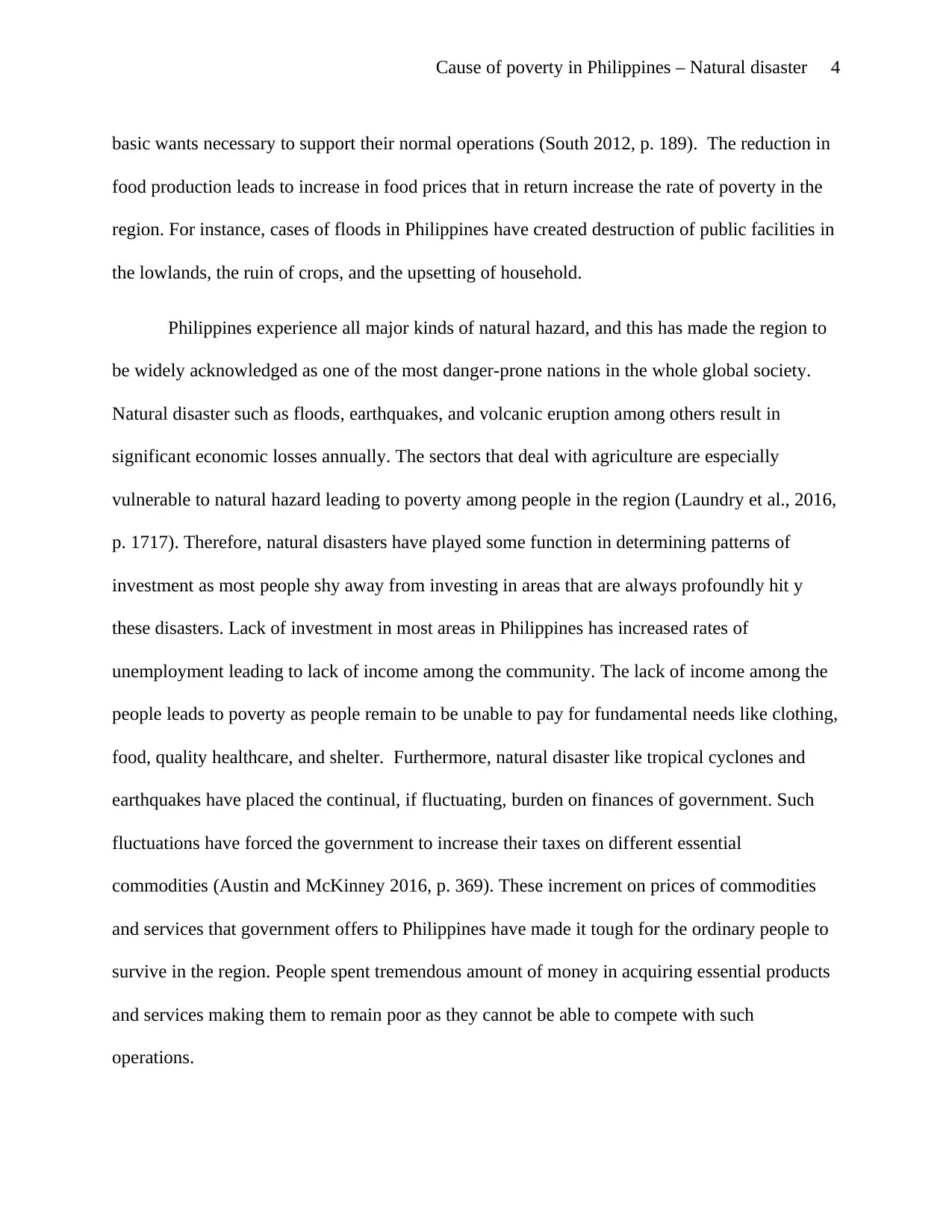
Cause of poverty in Philippines – Natural disaster 4
basic wants necessary to support their normal operations (South 2012, p. 189). The reduction in
food production leads to increase in food prices that in return increase the rate of poverty in the
region. For instance, cases of floods in Philippines have created destruction of public facilities in
the lowlands, the ruin of crops, and the upsetting of household.
Philippines experience all major kinds of natural hazard, and this has made the region to
be widely acknowledged as one of the most danger-prone nations in the whole global society.
Natural disaster such as floods, earthquakes, and volcanic eruption among others result in
significant economic losses annually. The sectors that deal with agriculture are especially
vulnerable to natural hazard leading to poverty among people in the region (Laundry et al., 2016,
p. 1717). Therefore, natural disasters have played some function in determining patterns of
investment as most people shy away from investing in areas that are always profoundly hit y
these disasters. Lack of investment in most areas in Philippines has increased rates of
unemployment leading to lack of income among the community. The lack of income among the
people leads to poverty as people remain to be unable to pay for fundamental needs like clothing,
food, quality healthcare, and shelter. Furthermore, natural disaster like tropical cyclones and
earthquakes have placed the continual, if fluctuating, burden on finances of government. Such
fluctuations have forced the government to increase their taxes on different essential
commodities (Austin and McKinney 2016, p. 369). These increment on prices of commodities
and services that government offers to Philippines have made it tough for the ordinary people to
survive in the region. People spent tremendous amount of money in acquiring essential products
and services making them to remain poor as they cannot be able to compete with such
operations.
basic wants necessary to support their normal operations (South 2012, p. 189). The reduction in
food production leads to increase in food prices that in return increase the rate of poverty in the
region. For instance, cases of floods in Philippines have created destruction of public facilities in
the lowlands, the ruin of crops, and the upsetting of household.
Philippines experience all major kinds of natural hazard, and this has made the region to
be widely acknowledged as one of the most danger-prone nations in the whole global society.
Natural disaster such as floods, earthquakes, and volcanic eruption among others result in
significant economic losses annually. The sectors that deal with agriculture are especially
vulnerable to natural hazard leading to poverty among people in the region (Laundry et al., 2016,
p. 1717). Therefore, natural disasters have played some function in determining patterns of
investment as most people shy away from investing in areas that are always profoundly hit y
these disasters. Lack of investment in most areas in Philippines has increased rates of
unemployment leading to lack of income among the community. The lack of income among the
people leads to poverty as people remain to be unable to pay for fundamental needs like clothing,
food, quality healthcare, and shelter. Furthermore, natural disaster like tropical cyclones and
earthquakes have placed the continual, if fluctuating, burden on finances of government. Such
fluctuations have forced the government to increase their taxes on different essential
commodities (Austin and McKinney 2016, p. 369). These increment on prices of commodities
and services that government offers to Philippines have made it tough for the ordinary people to
survive in the region. People spent tremendous amount of money in acquiring essential products
and services making them to remain poor as they cannot be able to compete with such
operations.
Paraphrase This Document
Need a fresh take? Get an instant paraphrase of this document with our AI Paraphraser

Cause of poverty in Philippines – Natural disaster 5
Figure 2: Picture showing how natural disaster leads to destruction of property in Philippines
Disaster vulnerability together with degradation of environment is integrally connected,
and natural hazards have played the vital role in reinforcing poverty. The occurrences of such
risks have made more attention to be paid to management of such disaster, but these efforts have
concentrated mainly on preparedness along with post-disaster response (Eastin 2016, p. 332).
The focus on management while assuming how to improve the quality of lives of people that
have been affected by such natural disasters make more people to suffer as they cannot be able to
support their lives by acquiring enough food, having appropriate housing, and improving their
heaths. Conversely, donor have focused on developing their services on strengthening disaster-
related operation to primarily concentrate on preparedness and response, rather than prevention
as well as mitigation measures. Such concentrations leaves many people in Philippines to live
below poverty line as they are unable to improve their lives after their essential belongings are
affected by occurrences of natural disaster (Brown et al 2014, p. 392). For instance, degraded
Figure 2: Picture showing how natural disaster leads to destruction of property in Philippines
Disaster vulnerability together with degradation of environment is integrally connected,
and natural hazards have played the vital role in reinforcing poverty. The occurrences of such
risks have made more attention to be paid to management of such disaster, but these efforts have
concentrated mainly on preparedness along with post-disaster response (Eastin 2016, p. 332).
The focus on management while assuming how to improve the quality of lives of people that
have been affected by such natural disasters make more people to suffer as they cannot be able to
support their lives by acquiring enough food, having appropriate housing, and improving their
heaths. Conversely, donor have focused on developing their services on strengthening disaster-
related operation to primarily concentrate on preparedness and response, rather than prevention
as well as mitigation measures. Such concentrations leaves many people in Philippines to live
below poverty line as they are unable to improve their lives after their essential belongings are
affected by occurrences of natural disaster (Brown et al 2014, p. 392). For instance, degraded

Cause of poverty in Philippines – Natural disaster 6
state of the environment along with natural resources of Philippines are felt most intensely by the
poor mainly rural communities given that they rely on these resources for their primary sources
of living. For instance, for three straight years in Philippines, typhoons in the region have killed
more than one thousand individuals, despite massive initiative by authority to reduce risk of
disaster. Occurrence of typhoon Haiyan that ripped through the central Philippines islands
murdered more than three thousand six hundred and displaced two million individuals.
Natural disaster such as floods, hurricanes, drought, together with earthquakes has
devastated communities that reside in Philippines. The people in this area often suffer from more
extensive as well as sensitive crises at hand of natural catastrophe since restricted resources
always restrain creation of sufficient housing, networks such as roads, along with mechanism for
reacting to disasters (Morin et al., 2016, p. 704). In many parts of Philippines, natural disaster
results to environmental degradation that include atmosphere, water bodies, forests, and soil that
remain to be significant cause of poverty. Such cases of ecological problems in the area have led
to shortage of clean water, food, material for shelter, and other vital resources for survival of
people and their wellbeing (Kure et al., 2016, p. 1153). As air, land, water, together with forests
are tainted, individual who reside straightly off these natural assets endure most these effects.
Table below show Typhoon Nesat along with Tropical Storm Washi in Philippines in September
together with December in 2011
Country data
Population per Rank Human Growth Rank Index Total GDP per individual
rank
102 million per twelve 112 34 per 125
state of the environment along with natural resources of Philippines are felt most intensely by the
poor mainly rural communities given that they rely on these resources for their primary sources
of living. For instance, for three straight years in Philippines, typhoons in the region have killed
more than one thousand individuals, despite massive initiative by authority to reduce risk of
disaster. Occurrence of typhoon Haiyan that ripped through the central Philippines islands
murdered more than three thousand six hundred and displaced two million individuals.
Natural disaster such as floods, hurricanes, drought, together with earthquakes has
devastated communities that reside in Philippines. The people in this area often suffer from more
extensive as well as sensitive crises at hand of natural catastrophe since restricted resources
always restrain creation of sufficient housing, networks such as roads, along with mechanism for
reacting to disasters (Morin et al., 2016, p. 704). In many parts of Philippines, natural disaster
results to environmental degradation that include atmosphere, water bodies, forests, and soil that
remain to be significant cause of poverty. Such cases of ecological problems in the area have led
to shortage of clean water, food, material for shelter, and other vital resources for survival of
people and their wellbeing (Kure et al., 2016, p. 1153). As air, land, water, together with forests
are tainted, individual who reside straightly off these natural assets endure most these effects.
Table below show Typhoon Nesat along with Tropical Storm Washi in Philippines in September
together with December in 2011
Country data
Population per Rank Human Growth Rank Index Total GDP per individual
rank
102 million per twelve 112 34 per 125
⊘ This is a preview!⊘
Do you want full access?
Subscribe today to unlock all pages.

Trusted by 1+ million students worldwide
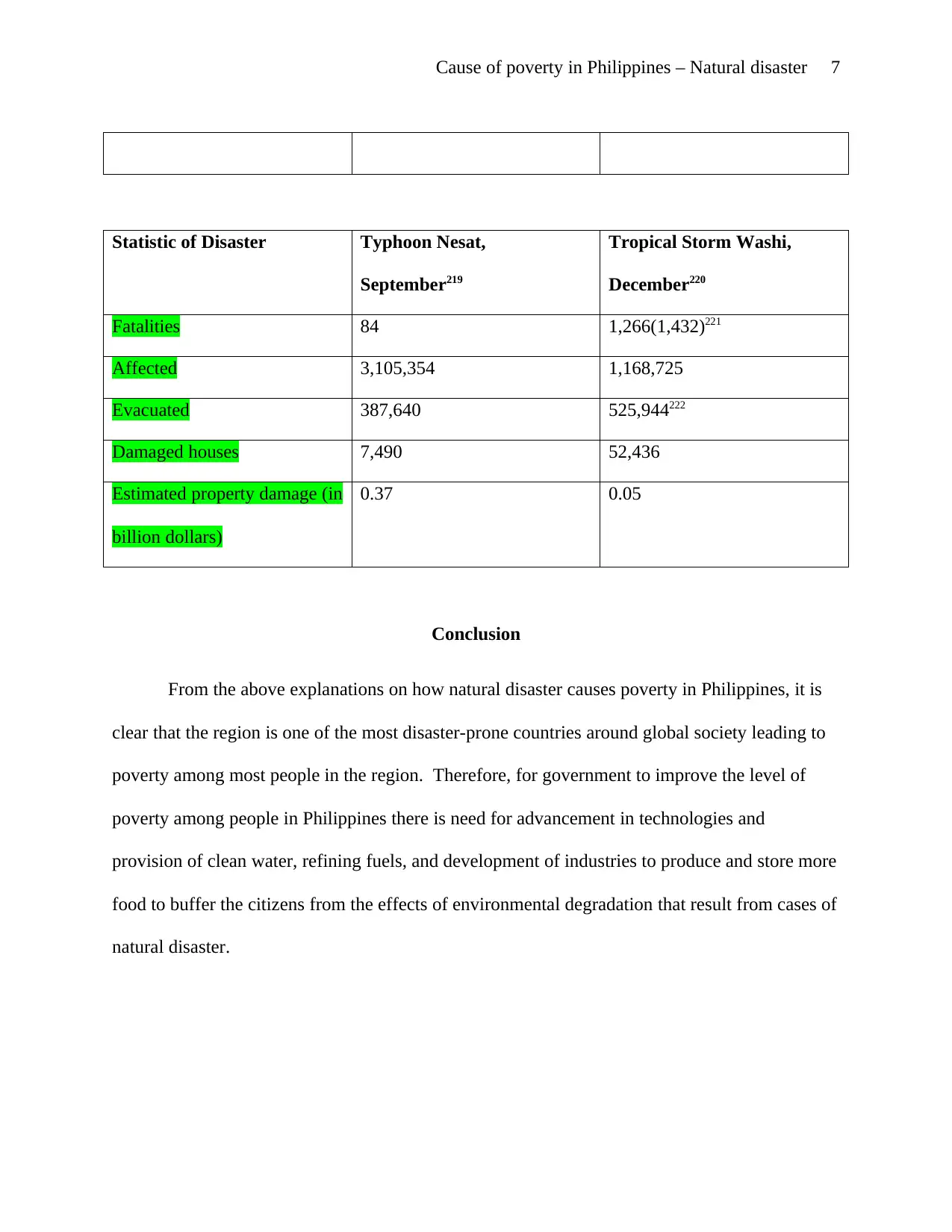
Cause of poverty in Philippines – Natural disaster 7
Statistic of Disaster Typhoon Nesat,
September219
Tropical Storm Washi,
December220
Fatalities 84 1,266(1,432)221
Affected 3,105,354 1,168,725
Evacuated 387,640 525,944222
Damaged houses 7,490 52,436
Estimated property damage (in
billion dollars)
0.37 0.05
Conclusion
From the above explanations on how natural disaster causes poverty in Philippines, it is
clear that the region is one of the most disaster-prone countries around global society leading to
poverty among most people in the region. Therefore, for government to improve the level of
poverty among people in Philippines there is need for advancement in technologies and
provision of clean water, refining fuels, and development of industries to produce and store more
food to buffer the citizens from the effects of environmental degradation that result from cases of
natural disaster.
Statistic of Disaster Typhoon Nesat,
September219
Tropical Storm Washi,
December220
Fatalities 84 1,266(1,432)221
Affected 3,105,354 1,168,725
Evacuated 387,640 525,944222
Damaged houses 7,490 52,436
Estimated property damage (in
billion dollars)
0.37 0.05
Conclusion
From the above explanations on how natural disaster causes poverty in Philippines, it is
clear that the region is one of the most disaster-prone countries around global society leading to
poverty among most people in the region. Therefore, for government to improve the level of
poverty among people in Philippines there is need for advancement in technologies and
provision of clean water, refining fuels, and development of industries to produce and store more
food to buffer the citizens from the effects of environmental degradation that result from cases of
natural disaster.
Paraphrase This Document
Need a fresh take? Get an instant paraphrase of this document with our AI Paraphraser
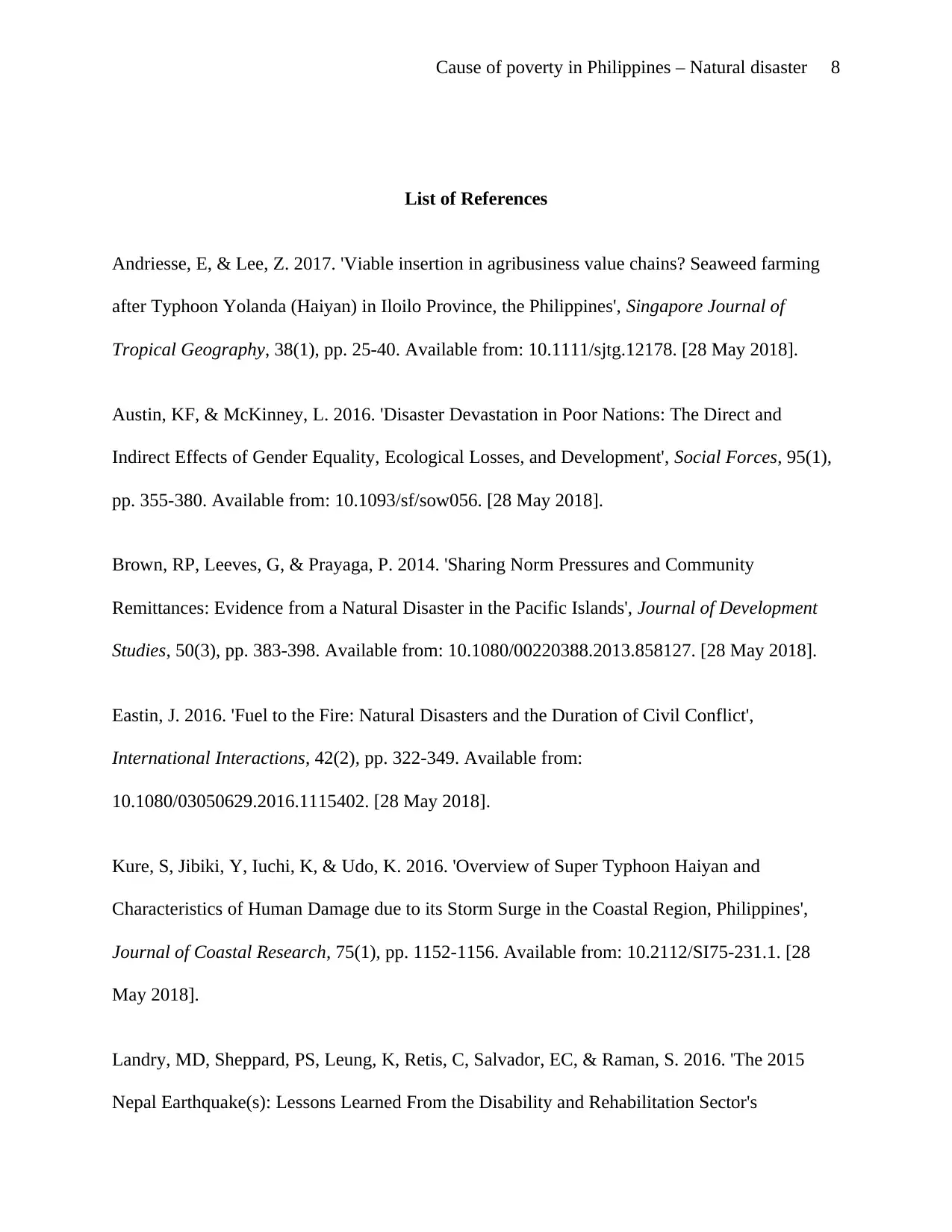
Cause of poverty in Philippines – Natural disaster 8
List of References
Andriesse, E, & Lee, Z. 2017. 'Viable insertion in agribusiness value chains? Seaweed farming
after Typhoon Yolanda (Haiyan) in Iloilo Province, the Philippines', Singapore Journal of
Tropical Geography, 38(1), pp. 25-40. Available from: 10.1111/sjtg.12178. [28 May 2018].
Austin, KF, & McKinney, L. 2016. 'Disaster Devastation in Poor Nations: The Direct and
Indirect Effects of Gender Equality, Ecological Losses, and Development', Social Forces, 95(1),
pp. 355-380. Available from: 10.1093/sf/sow056. [28 May 2018].
Brown, RP, Leeves, G, & Prayaga, P. 2014. 'Sharing Norm Pressures and Community
Remittances: Evidence from a Natural Disaster in the Pacific Islands', Journal of Development
Studies, 50(3), pp. 383-398. Available from: 10.1080/00220388.2013.858127. [28 May 2018].
Eastin, J. 2016. 'Fuel to the Fire: Natural Disasters and the Duration of Civil Conflict',
International Interactions, 42(2), pp. 322-349. Available from:
10.1080/03050629.2016.1115402. [28 May 2018].
Kure, S, Jibiki, Y, Iuchi, K, & Udo, K. 2016. 'Overview of Super Typhoon Haiyan and
Characteristics of Human Damage due to its Storm Surge in the Coastal Region, Philippines',
Journal of Coastal Research, 75(1), pp. 1152-1156. Available from: 10.2112/SI75-231.1. [28
May 2018].
Landry, MD, Sheppard, PS, Leung, K, Retis, C, Salvador, EC, & Raman, S. 2016. 'The 2015
Nepal Earthquake(s): Lessons Learned From the Disability and Rehabilitation Sector's
List of References
Andriesse, E, & Lee, Z. 2017. 'Viable insertion in agribusiness value chains? Seaweed farming
after Typhoon Yolanda (Haiyan) in Iloilo Province, the Philippines', Singapore Journal of
Tropical Geography, 38(1), pp. 25-40. Available from: 10.1111/sjtg.12178. [28 May 2018].
Austin, KF, & McKinney, L. 2016. 'Disaster Devastation in Poor Nations: The Direct and
Indirect Effects of Gender Equality, Ecological Losses, and Development', Social Forces, 95(1),
pp. 355-380. Available from: 10.1093/sf/sow056. [28 May 2018].
Brown, RP, Leeves, G, & Prayaga, P. 2014. 'Sharing Norm Pressures and Community
Remittances: Evidence from a Natural Disaster in the Pacific Islands', Journal of Development
Studies, 50(3), pp. 383-398. Available from: 10.1080/00220388.2013.858127. [28 May 2018].
Eastin, J. 2016. 'Fuel to the Fire: Natural Disasters and the Duration of Civil Conflict',
International Interactions, 42(2), pp. 322-349. Available from:
10.1080/03050629.2016.1115402. [28 May 2018].
Kure, S, Jibiki, Y, Iuchi, K, & Udo, K. 2016. 'Overview of Super Typhoon Haiyan and
Characteristics of Human Damage due to its Storm Surge in the Coastal Region, Philippines',
Journal of Coastal Research, 75(1), pp. 1152-1156. Available from: 10.2112/SI75-231.1. [28
May 2018].
Landry, MD, Sheppard, PS, Leung, K, Retis, C, Salvador, EC, & Raman, S. 2016. 'The 2015
Nepal Earthquake(s): Lessons Learned From the Disability and Rehabilitation Sector's
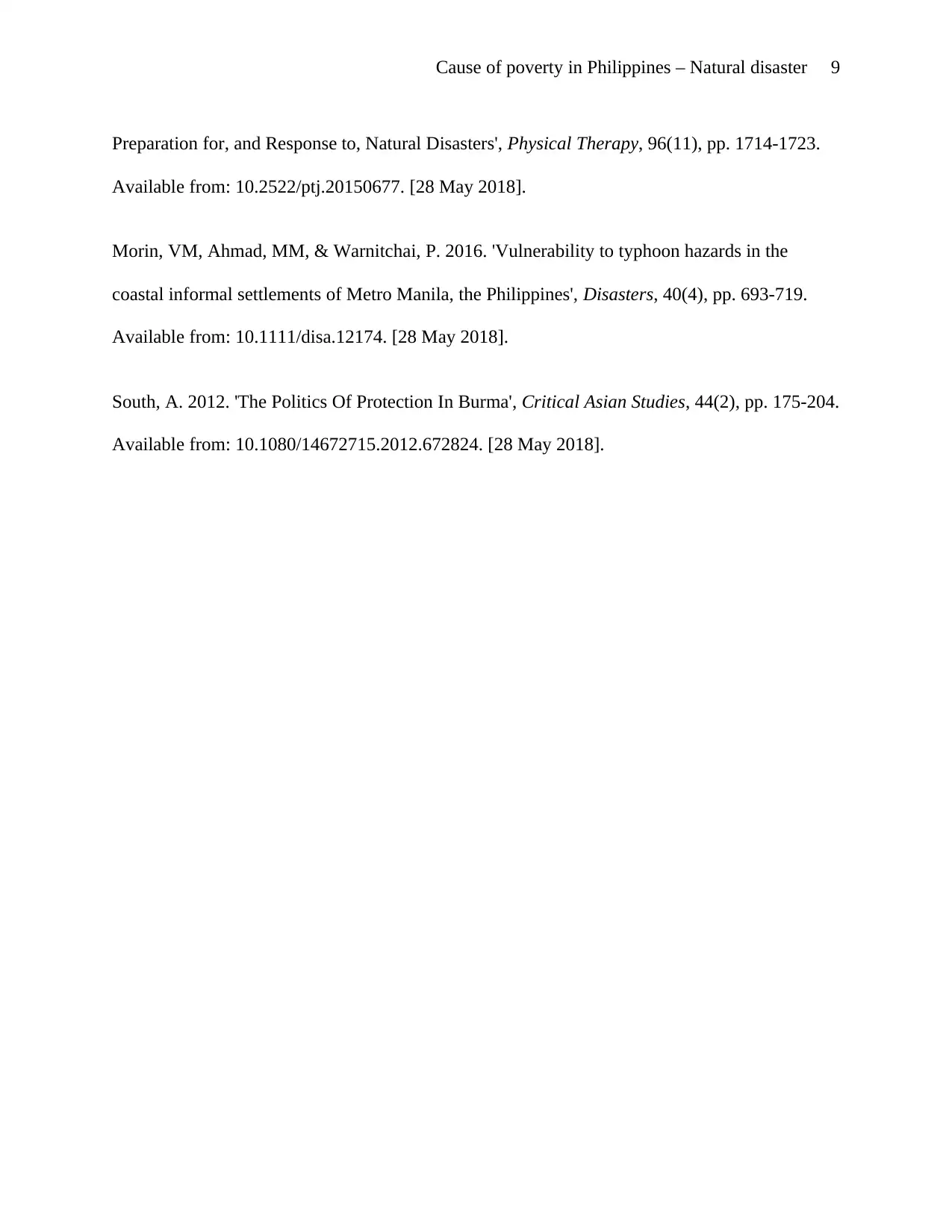
Cause of poverty in Philippines – Natural disaster 9
Preparation for, and Response to, Natural Disasters', Physical Therapy, 96(11), pp. 1714-1723.
Available from: 10.2522/ptj.20150677. [28 May 2018].
Morin, VM, Ahmad, MM, & Warnitchai, P. 2016. 'Vulnerability to typhoon hazards in the
coastal informal settlements of Metro Manila, the Philippines', Disasters, 40(4), pp. 693-719.
Available from: 10.1111/disa.12174. [28 May 2018].
South, A. 2012. 'The Politics Of Protection In Burma', Critical Asian Studies, 44(2), pp. 175-204.
Available from: 10.1080/14672715.2012.672824. [28 May 2018].
Preparation for, and Response to, Natural Disasters', Physical Therapy, 96(11), pp. 1714-1723.
Available from: 10.2522/ptj.20150677. [28 May 2018].
Morin, VM, Ahmad, MM, & Warnitchai, P. 2016. 'Vulnerability to typhoon hazards in the
coastal informal settlements of Metro Manila, the Philippines', Disasters, 40(4), pp. 693-719.
Available from: 10.1111/disa.12174. [28 May 2018].
South, A. 2012. 'The Politics Of Protection In Burma', Critical Asian Studies, 44(2), pp. 175-204.
Available from: 10.1080/14672715.2012.672824. [28 May 2018].
⊘ This is a preview!⊘
Do you want full access?
Subscribe today to unlock all pages.

Trusted by 1+ million students worldwide
1 out of 9
Related Documents
Your All-in-One AI-Powered Toolkit for Academic Success.
+13062052269
info@desklib.com
Available 24*7 on WhatsApp / Email
![[object Object]](/_next/static/media/star-bottom.7253800d.svg)
Unlock your academic potential
Copyright © 2020–2025 A2Z Services. All Rights Reserved. Developed and managed by ZUCOL.





